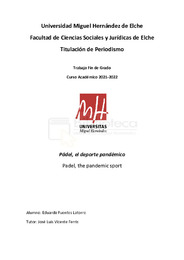Por favor, use este identificador para citar o enlazar este ítem:
https://hdl.handle.net/11000/28663Registro completo de metadatos
| Campo DC | Valor | Lengua/Idioma |
|---|---|---|
| dc.contributor.advisor | Ferris, José Luis | - |
| dc.contributor.author | Fuentes Latorre, Eduardo | - |
| dc.contributor.other | Departamentos de la UMH::Ciencias Sociales y Humanas | es_ES |
| dc.date.accessioned | 2022-12-20T13:33:50Z | - |
| dc.date.available | 2022-12-20T13:33:50Z | - |
| dc.date.created | 2022-09 | - |
| dc.identifier.uri | https://hdl.handle.net/11000/28663 | - |
| dc.description.abstract | El pádel se ha convertido en uno de los deportes de raqueta más populares en la actualidad. Con origen en México y rivalizando, e incluso superando, en los últimos tiempos con el tenis, su popularidad en España se remonta a su llegada en la década de los años 70 coincidiendo también con el desembarco de este deporte en Argentina. Así, los dos países hispanohablantes se han convertido en los territorios que presentan un mayor índice de jugadores respecto al total mundial. El primer gran boom del pádel en España se remonta a la década de los 2010, coincidiendo con el desembarco de World Padel Tour (WPT), la principal competición profesional de pádel. Sin embargo, un hecho reciente ha supuesto un nuevo incremento en la popularidad de este deporte. La pandemia de la COVID-19 afectó en todos los ámbitos de la vida cotidiana, incluyendo el deporte. Aún así, las restricciones sanitarias post confinamiento otorgaron al pádel de un valor especial debido a las características del propio juego. La necesidad de pocas personas para su práctica y poder hacerlo en un ambiente controlado sirvieron para que fuera uno de los deportes más practicados y con más crecimiento durante la pandemia. | es_ES |
| dc.description.abstract | Paddle tennis has become one of the most popular racket sports today. With its origins in Mexico and rivaling, and even surpassing, tennis in recent times, its popularity in Spain dates to its arrival in the 70's, coinciding also with the arrival of this sport in Argentina. Thus, the two Spanish-speaking countries have become the territories with the highest number of players in relation to the world total. The first great padel boom in Spain dates to the 2010s, coinciding with the arrival of the World Padel Tour (WPT), the main professional padel competition. However, a recent event has brought a new surge in the popularity of the sport. The COVID-19 pandemic affected all areas of daily life, including sport. Even so, the post-confinement health restrictions gave paddle tennis a special value due to the characteristics of the game itself. The need for few people to play and being able to do so in a controlled environment made it one of the most popular and fastest-growing sports during the pandemic. | es_ES |
| dc.format | application/pdf | es_ES |
| dc.format.extent | 32 | es_ES |
| dc.language.iso | spa | es_ES |
| dc.publisher | Universidad Miguel Hernández de Elche | es_ES |
| dc.rights | info:eu-repo/semantics/openAccess | es_ES |
| dc.rights.uri | http://creativecommons.org/licenses/by-nc-nd/4.0/ | * |
| dc.subject | pádel | es_ES |
| dc.subject | deporte | es_ES |
| dc.subject | pandemia | es_ES |
| dc.subject | crecimiento | es_ES |
| dc.subject | investigación | es_ES |
| dc.subject | paddle tennis | es_ES |
| dc.subject | sport | es_ES |
| dc.subject | pandemic | es_ES |
| dc.subject | growth | es_ES |
| dc.subject | research | es_ES |
| dc.subject.other | CDU::0 - Generalidades.::070 - Periódicos. Prensa. Periodismo. Ciencias de la información | es_ES |
| dc.title | Pádel, el deporte pandémico | es_ES |
| dc.title.alternative | Padel, the pandemic sport | es_ES |
| dc.type | info:eu-repo/semantics/bachelorThesis | es_ES |

Ver/Abrir:
TFG-Fuentes Latorre, Eduardo.pdf
1,08 MB
Adobe PDF
Compartir:
 La licencia se describe como: Atribución-NonComercial-NoDerivada 4.0 Internacional.
La licencia se describe como: Atribución-NonComercial-NoDerivada 4.0 Internacional.
.png)